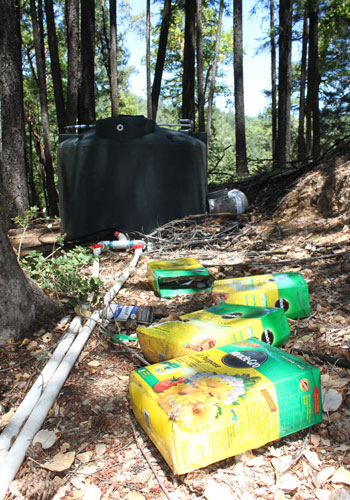
Discarded fertilizer boxes reflect not only how marijuana cultivation is introducing agro-chemicals into sensitive natural landscapes, but also trash and solid waste pollution. Additionally, the water tank and tubing provide evidence of the type of irrigation infrastructure utilized. (Photo by Jennifer Carah, The Nature Conservancy)
The debate over the legalization of marijuana has focused primarily on questions of law, policy and health. But a new paper co-authored by UC Berkeley researchers shines a spotlight on the environment as an underappreciated victim of the plant’s growing popularity as a cash crop.
Published today in the journal Bioscience, the report outlines how illegal marijuana production is hitting California where it hurts, such as in sensitive watersheds already stressed by the state’s ongoing drought. Networks of pipes and hoses siphon water directly from small streams to irrigate the crops, draining what little water there is for wildlife and plants.
Moreover, heavy use of pesticides and poison to keep rats from eating the crops has also polluted the landscape and water. In some cases, the toxins have made their way into the terrestrial food chain, sickening or killing predators that feed on the rats, including Pacific fishers, a candidate for listing under the Endangered Species Act.
The ecological impact has only worsened since the state’s voters legalized the medical use of pot in 1996, creating a “green rush” of marijuana growers seeking to make a profit.
Led by researchers from the Nature Conservancy, the study included significant UC Berkeley contributions from freshwater fish ecologist Stephanie Carlson, an associate professor of environmental sciences, policy and management; stream ecologist Mary Power, a professor of integrative biology; ecohydrologist Sally Thompson, an assistant professor of environmental engineering; and applied mathematician David Dralle, a Ph.D. student in environmental engineering.
“The environmental harm caused by marijuana cultivation has largely been ignored, but this is a mistake,” said Carlson. “Marijuana is a thirsty crop that often relies on surface water diversions during California’s summer dry season. While many of our native aquatic organisms are adapted to California’s Mediterranean seasonality, the combination of our current drought and summer water diversions for marijuana could be a one-two punch that drives declines in several sensitive populations.”
